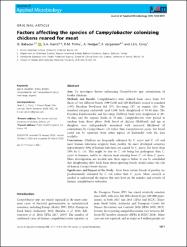| dc.contributor.author | Babacan, Orkun | |
| dc.contributor.author | Harris, Stephen A. | |
| dc.contributor.author | Pinho, R. M. | |
| dc.contributor.author | Hedges, Alan John | |
| dc.contributor.author | JØrgensen, Frieda | |
| dc.contributor.author | Ćorry, Janet E.L. | |
| dc.date.accessioned | 2021-03-26T06:40:38Z | |
| dc.date.available | 2021-03-26T06:40:38Z | |
| dc.date.issued | 2020 | en_US |
| dc.identifier.issn | 1364-5072 | |
| dc.identifier.issn | 1365-2672 | |
| dc.identifier.uri | https://doi.org/10.1111/jam.14651 | |
| dc.identifier.uri | https://hdl.handle.net/20.500.12462/11320 | |
| dc.description | Babacan, Orkun (Balikesir Author) | en_US |
| dc.description.abstract | Aim To investigate factors influencing Campylobacter spp. colonization of broiler chickens.
Methods and Results Campylobacters were isolated from caeca from 319 flocks of two different breeds (199 Cobb and 120 Hubbard), reared as standard (199), Freedom Food/corn fed (57), free-range (47) or organic (16). The standard category exclusively used Cobb birds slaughtered at 38-41 days. The Freedom Food/corn-fed and free-range Hubbard birds were slaughtered at 49-56 days and the organic flocks at 70 days. Campylobacters were picked at random from direct plates. Both breed of chicken (Hubbard) and age at slaughter were independently associated with increased likelihood of colonization by Campylobacter coli rather than Campylobacter jejuni, but breed could not be separated from other aspects of husbandry with the data available.
Conclusions Chickens are frequently colonized by C. jejuni and C. coli and most human infections originate from poultry. In most developed countries approximately 90% of human infections are caused by C. jejuni, but fewer than 10% by C. coli. This might be due to C. coli being less pathogenic than C. jejuni to humans, and/or to chicken meat carrying fewer C. coli than C. jejuni. More investigations are needed into these aspects before it can be concluded that slaughtering older birds from slower-growing breeds would reduce the risk of human Campylobacter disease.
Significance and Impact of the Study Meat from certain breeds of poultry are predominantly colonized by C. coli rather than C. jejuni. More research is needed to understand the impact this may have on the number and severity of human campylobacter infections. | en_US |
| dc.description.sponsorship | UK Food Standards Agency M01039 | en_US |
| dc.language.iso | eng | en_US |
| dc.publisher | Wiley | en_US |
| dc.relation.isversionof | 10.1111/jam.14651 | en_US |
| dc.rights | info:eu-repo/semantics/openAccess | en_US |
| dc.subject | Age at Slaughter | en_US |
| dc.subject | Breed | en_US |
| dc.subject | Broilers | en_US |
| dc.subject | Campylobacter Coli | en_US |
| dc.subject | Campylobacter Jejuni | en_US |
| dc.subject | Free-Range | en_US |
| dc.subject | Organic | en_US |
| dc.title | Factors affecting the species of Campylobacter colonizing chickens reared for meat | en_US |
| dc.type | article | en_US |
| dc.relation.journal | Journal of Applied Microbiology | en_US |
| dc.contributor.department | Kepsut Meslek Yüksekokulu | en_US |
| dc.contributor.authorID | 0000-0003-0258-1825 | en_US |
| dc.identifier.volume | 129 | en_US |
| dc.identifier.issue | 4 | en_US |
| dc.identifier.startpage | 1071 | en_US |
| dc.identifier.endpage | 1078 | en_US |
| dc.relation.publicationcategory | Makale - Uluslararası Hakemli Dergi - Kurum Öğretim Elemanı | en_US |


















